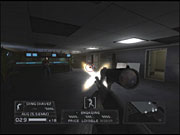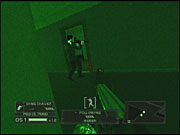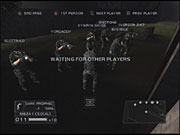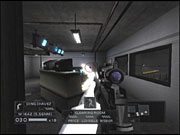There's no negotiating with terrorists in Tom Clancy's Rainbow Six 3. As an elite counterterrorist operative, you and your team will be called upon to settle highly sensitive situations with decisive force. Armed with your choice of the world's deadliest firearms, you'll neutralize the enemy and rescue any hostages, then leave without a trace. Tactical squad-based shooters, such as Rainbow Six 3, aren't uncommon at this point, though the Rainbow Six series, which debuted on the PC in 1998, has been instrumental in solidifying this popular style of gaming. Interestingly, this series has never made much of an impact on consoles--until now. Rainbow Six 3 for the Xbox, based on (but not a port of) this year's PC shooter Rainbow Six 3: Raven Shield, offers great online and offline play and features a remarkable variety of carefully modeled real-world weapons. Despite some issues with the game's online performance and artificial intelligence, Rainbow Six 3 delivers quite possibly the tensest, most serious first-person shooter experiences on the Xbox to date.

Rainbow is the name of author Tom Clancy's fictional counterterrorist unit, composed of the world's strongest, fastest, most highly trained sharpshooters and commandos. Basically, Rainbow is deployed to clean up big messes when there's no other recourse. Like other Rainbow Six titles, Rainbow Six 3 is a shooter, set in the real world, that strives for realism. Death comes swiftly, as just one or two bullets will be enough to take out most targets, and you yourself can't sustain much damage either. Tactics, initiative, and the element of surprise are your greatest weapons, though the submachine guns and assault rifles are pretty handy too. You cannot jump, and you cannot sprint. Unfortunately, you cannot lie prone, but you may crouch and move while crouched, which is often the best course of action. Your "special powers" are limited to an onscreen map of your surroundings, which also reveals the direction from which you're taking fire. You get night vision and thermal vision too. Your means of attack are limited to the primary and secondary weapons and grenades that you choose to bring with you into a mission, and, for reasons that aren't terribly clear, you cannot pick up and use any weapons dropped by those who've been shot. So, in essence, Rainbow Six 3 is a simple game of kill-or-be-killed. You'd better learn to aim faster and truer than your enemies.
The game features a good variety of modes for play, both online and off. There's a linear, single-player campaign, featuring more than a dozen missions and three levels of difficulty (all of which, in fact, are challenging). In the campaign, you play as Domingo "Ding" Chavez, Rainbow's best. At your side will be up to three other Rainbow operatives per mission. The campaign features an overarching storyline, involving South American terrorists, and other political intrigue that you'd expect from Tom Clancy. The missions themselves take place all over the world, in the sorts of mundane yet tactically intriguing settings you'd expect, from airports to chateaus. They tend to be packed with tangos, as well as a few hostages and maybe a few bombs, which you'll need to take care of or else the mission fails.
The missions aren't lengthy, per se, but since they're difficult, they can take a while. You and your team can't survive more than a few hits. Team members who are "incapacitated" by gunfire will be out for the remainder of that mission, though they'll magically return in subsequent missions. And if Ding dies--game over. You may save anywhere during the missions, but only a limited number of times. This is a fine way of giving you the flexibility to save your progress without letting you smugly save after every kill. The missions are quite heavily scripted though, so a trial-and-error process can eventually see you through if you aren't quick enough to react to the surprises around every corner.
Some of the enemies are crack shots, and some will use grenades, but their artificial intelligence can be pretty spotty. They'll run headlong into certain death sometimes, though on other occasions, you'll see them spraying bullets blindly from behind cover. They'll also exhibit other actions more along the lines of what you'd expect from a bunch of armed thugs. Likewise, your own teammates are prone to impressive feats of tactical expertise, as well as incredible stupidity. When ordered to hold position, they'll logically cover the area from every angle. They'll enter rooms while watching each others' backs, and, in many cases, they'll save your hide. However, sometimes they'll throw grenades down at their feet, and sometimes they'll get stuck trying to get past one another. They'll also shout things to you after the fact. Rainbow Six 3 is a realistic game, in general, so these occasional AI flukes tend to really stick out.

In addition to the campaign, there's also a cool "custom mission" option, which lets you delve into any of the levels you've seen in the campaign to take on enemies who will appear in different places each time. This adds some pretty good single-player replay value, since the core action of the game is solid. Rainbow Six 3 also offers system link support, if you'd care to hook up multiple televisions and Xboxes, but there's no split-screen multiplayer mode. Consider the concept of the split-screen multiplayer console shooter dead.
Then there's the online component, which is the main attraction in Rainbow Six 3. It features five different modes of play, two of which are cooperative versions of the campaign and custom mission modes, suitable for up to four players. The other three are essentially deathmatch variants for up to 16 players. The sharpshooter mode is a timed match where you may respawn when killed, and whoever earns the most kills, wins. Survival and team survival require more patience, since they force you to sit out the rest of the round if you die, and whichever player or team is left standing is declared the winner. Rainbow Six 3 primarily consists of brutal close-quarters battles, and, with its online play features, it's the closest console-game equivalent of the extraordinarily popular PC shooter, Counter-Strike. However, it does lack the objective-based multiplayer modes found in games like Counter-Strike or Return to Castle Wolfenstein: Enemy Territory, which are popular for the good reason that they instill a sense of purpose in players that goes beyond just "kill all the other guys." Anyway, the co-op modes are there to scratch that itch, and the competitive modes offer pure, realistic shooting action. We did experience some sporadic lag in games with both small and large numbers of players, and this lag was irrespective of the apparent quality of our connection speed to the host. In a game where speed is everything, lag can be particularly frustrating, but as ESRB likes to point out, "game experience may vary during online play."
The Rainbow Six games have always been more serious than the average shooter. On the PC, the series attracted its own devoted following, separate from all the Quake and Unreal Tournament fans, because Rainbow Six wasn't just about shooting enemies--it was about commanding a team and executing a plan. These were relatively complicated elements and not until now have they been made truly accessible. Single-player Rainbow Six 3 dispenses with the mission planning phase of previous Rainbow Six games, puts you in the role of the best of the best among Rainbow's ranks, and features a surprisingly intuitive, context-sensitive squad command system, which lets you issue orders to up to three other computer-controlled teammates. You just look at something and press the A button. Then your team will do what's natural, like advance to a new position, open a door and clear the next room, defuse a bomb, and so on. Sometimes there are more options available. For instance, pressing and holding A on a door allows you to order your team to toss a flashbang or frag grenade into the room before advancing. Or, if you'd prefer, you can order them to use a breaching charge to blow the door right open. You may also use what's called the "zulu go-code" to queue up an order for a specified time. The order is executed when you press the white button, allowing you to coordinate simultaneous entry into a heavily fortified area. Additionally, the black button conveniently works as a toggle between ordering your team to form up behind you and ordering them to hold their positions.

Alternatively, much like last year's SOCOM: U.S. Navy SEALs for the PlayStation 2, Rainbow Six 3 allows you to give verbal orders to your AI-controlled team using the headset that comes with the Xbox Live starter kit. Speak clearly, and your team will readily respond to simple orders, like "move" and "hold," as well as more complex orders, like "secure hostage" and "breach and clear." Your team will only respond to these and a few other specific orders, so don't expect to be able to chat with them or anything. In fact, though it can be quite a thrill to see the AI respond to your speech--particularly if you've never experienced anything like it before--the game's more-conventional squad control mechanics work so well that you'll probably rely on them instead. The best part about using the headset with your computer-controlled team in the single-player portions of Rainbow Six 3 isn't the ability to give verbal orders, but it's the option to hear your team only through the headset, as opposed to the main speakers. Since the in-game characters are communicating via headsets already, hearing them over yours contributes a lot to the immersive feel of the game.
Gun fanatics will love Rainbow Six 3's great-looking, meticulously modeled, and substantial variety of weapons. Various real-life pistols, submachine guns, assault rifles, sniper rifles, and light machine guns are each rated for accuracy, range, and power. You may fire any of these weapons from the hip or you may use the scope if the weapon has one. You'll probably find that certain scoped submachine guns and assault rifles are far more effective than most of the other guns in the context of most of the game's scenarios, but, for the same reasons, such weapons are commonly used by real-life counterterrorist forces. The game features an interesting aiming system that, in a way, works opposite to what you'll find in games like Counter-Strike where your aiming reticle gets narrower when you're standing still to indicate that you'll be able to shoot within a more-precise area than if you were running around. In Rainbow Six 3, the aiming reticle is wider if you're standing still, and any enemy within this area will be auto-targeted. The reticle shrinks to a pinpoint when you're moving, forcing you to aim more precisely. This system works very well with Rainbow Six 3, a console shooter that you can't play with the split-second pinpoint accuracy afforded by the mouse-and-keyboard controls used for PC shooters.

Rainbow Six 3 is a great-looking game that believably re-creates the environments and types of characters you'd expect to see in a game like this. Character animations look good, in general, and rag-doll physics are used to good effect for death animations, as you'll see the tangos slump to the floor, lifeless, when struck by your fire. You'll see blood splattered on the walls after a firefight, and it will also be on the uniforms of injured team members. The game uses the same engine as seen in Tom Clancy's Splinter Cell but doesn't look as dramatic overall, even though many of Splinter Cell's great lighting effects have been brought over to this game. The frame rate is mostly steady but not perfectly smooth, and the game supports progressive scan displays. As far as the audio is concerned, the weapon effects are certainly the highlight. You've likely never heard louder or clearer gunfire in a game, and if you've got a Dolby Digital 5.1 setup, you'd better keep the volume down or else a real-life counterterrorist unit might break into your home. The voice acting in the game is also well done. One issue with the audio is that the otherwise nicely done between-mission cutscenes in the campaign are strangely quiet, though it's no big deal. There's not much music in the game, save for a very nice opening theme and some slightly corny, sad-sounding acoustic guitar plucking that occurs when one of your team members is taken out.
The single-player and multiplayer portions of Rainbow Six 3 combine to make this a great game that's easily recommended to Xbox owners looking for a realistic shooter. The game's core action is executed very well, and the variety of realistic weapons and locations should keep tactical shooter fans busy for a long time. There's even some downloadable content already available for the game, and, like some other current Xbox Live-compatible titles, Rainbow Six 3 offers a free trial of Microsoft's online gaming service. So don't hesitate to give the game a shot.